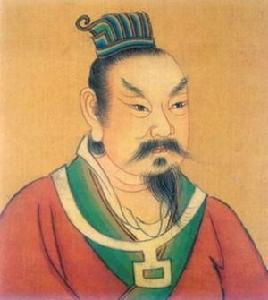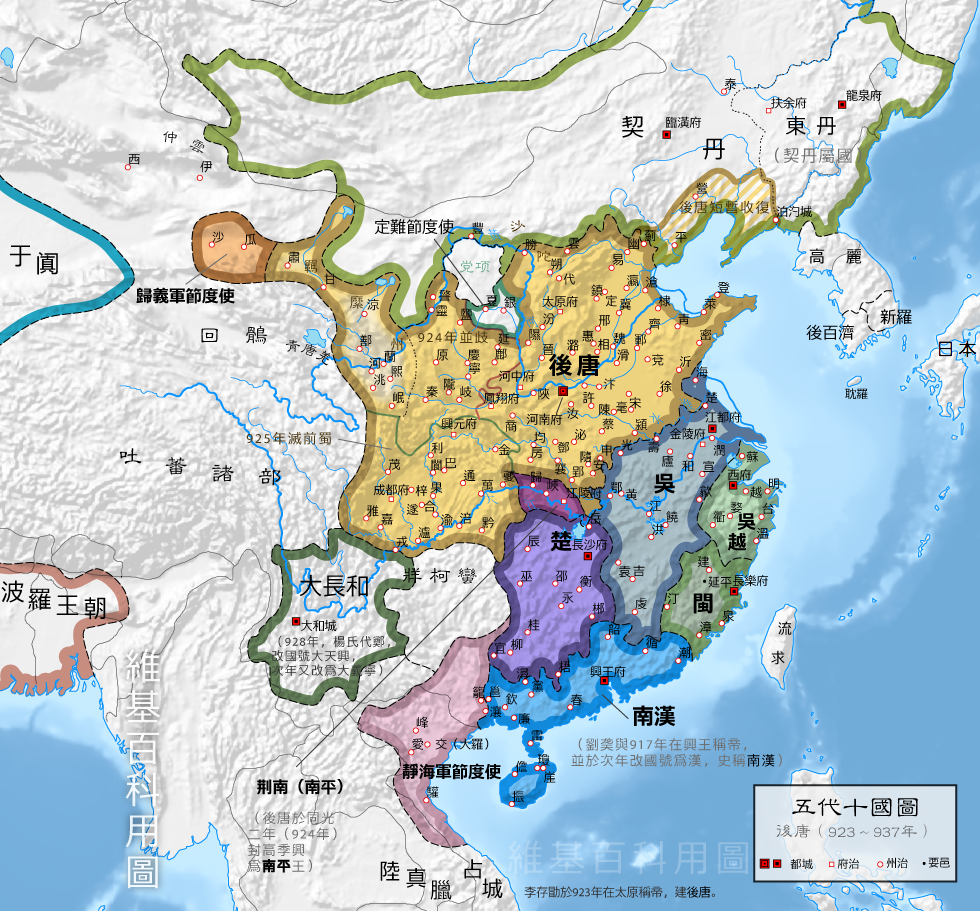 |
| The Tang Dynasty, famous for its space juice. |
China was a pretty strong empire under the Tang Dynasty. That is until it fell apart in 907 AD. This would be followed by a 72-period of frequent wars, conquests, coups, secessions, and usurpations that made China a revolving door of five different “dynasties” of rulers in the north, as well as ten different independent “kingdoms” in the south. Finally, in 979, the Song Dynasty got around to conquering everyone else and finally unified everyone back into a single "Chinese" Empire again. With the exception of the far north of China, which was still ruled by the Khitan (Liao) Empire. Oh yeah, and the west. That was all full of Xia, Tibetans, Mongols, and stuff like that. Let’s not worry about all those other places though.
Since the “dynasties” and “kingdoms” were a little different, I’m going to break this into two parts and rank the Five Dynasties against one another, and then for the next post I'll rank the Ten Kingdoms against one another. As I vaguely explained above:
- The Dynasties were typically all successor states to the Tang in the north, with each of the five dynasties coming right after the other by overthrowing the last one. While most of the dynasties claimed to rule all of China that the Tang had ruled, in reality they either totally lost control over much of the lands to the south (e.g. the Ten Kingdoms) or had given a large degree of autonomy to local military governors (known as “Jiedushi”). Rulers here were technically all "Emperors."
- The Kingdoms were states that failed to recognize the rule of the Dynasties and thus broke free from the northern Chinese dynasties. Instead of coming one right after the other with the dynasties, they ruled in various separate locations over various separate periods of time. Some became independent almost immediately after the fall of the Tang Dynasty, while others remained loyal to the new dynasties for some time before only later becoming independent. Rulers in these kingdoms took on all sorts of different titles at the time, ranging from “Prince” to “Emperor,” although retroactively they're typically referred to as “Kings.”
So here are (to start) the Five Dynasties… ranked.
5. Later Han
.jpg) |
| Later, but still a lot earlier than this Han. |
Not long after the Liao Empire obliterated the Later Jin into nothing in 947, the Liao’s own emperor, Taizong, died himself. The Liao then had a succession crisis of not knowing who their new emperor would be, which allowed just enough chaos for Liu Zhiyuan (the Jiedushi/military governor of Bingzhou, believed to be of Turk origin) to sweep in and claim the substantial chunk of land that used to be the Later Jin Dynasty (minus much of the Sixteen Prefectures and other land that the Jin had surrendered to the Liao). A pretty good accomplishment, if not for the fact that Zhiyuan died the very next year himself. His teenage son, Chengyou then took the throne but was only able to hold onto it for another two years before being ousted by Guo Wei in a military coup. In less than 4 years, it was all over. Yet it’s still called a “dynasty.”
- Length of Reign: 947 to 951 (less than 4 years)
- Size: Northern China, identical to the Later Jin.
- Notable Accomplishments: Knowing when to take advantage of a power vacuum. Dying really fast. Having a dynasty name that would have been a cool phrase for Kylo Ren to have said right when he killed his dad.
4. Later Zhou
 |
| Oh look, an actually relevant picture (at last). |
Guo Wei, the Han Chinese military advisor to the Turkic Later Han Dynasty, overthrew the teenage Han Emperor on New Years Day 951 and MADE CHINA GREAT AGAIN. But just for three years before he died. Emperors were dying left and right during this period. Wei’s adopted son, Rong, (he was the son of his wife’s brother) then took the throne of the Zhou Dynasty. Rong was actually able to increase the size of Zhou territory by having some victories against the Southern Tang. However, his efforts to engage the Northern Han were less than successful. After a whole five years of rule, he too died and his seven-year-old son took the throne. Well, you know how that goes in this time period. He was on the throne for less than a year before Zhao Kuangyin usurped the throne and declared himself emperor of the Great Song Dynasty. It’s all bad news for the Zhou, but the good news is that the Song Dynasty that would reunite China, bringing all of the southern states (and eventually by 979, the northern states) under its control and ending the period of the Five Dynasties and Ten Kingdoms.
- Length of Reign: 951 to 960 (9 years)
- Size: The same territory as the Later Han, but plus acquisitions from the Southern Tang.
- Notable Accomplishments: Military victories and land acquisition from the fairly large and powerful Southern Tang (essentially turning them into the Later Zhou’s puppet state).
3. Later Jin
 |
| Cunxu liked blue, I guess. |
The Later Jin and Later Tang were two branches of the same family (they were of the Shatuo ethnicity from Shanxi). In 936, Shi Jingtang (the son-in-law of Later Tang-founder Li Cunxu) overthrew his Tang family with the help of the Liao/Khitans, whose alliance with the Tang had fallen apart. Unfortunately, the Later Jin would never do quite as well as the Later Tang, as they were unable to ever claim Sichuan (the Later Tang actually lost it towards the end of their reign), and also had to cede up some of their land to their allies, the Liao (territories called “the Sixteen Prefectures,” which included Beijing and lands to its west. When Jingtang died his successor foolishly pissed off the Liao and they pretty much just conquered the Later Jin and destroyed them. Oops!
- Length of Reign: 936 to 947 (11 years)
- Size: Most of northern China, but not as much as the Later Tang, not being able to ever claim Sichuan and losing the Sixteen Prefectures.
- Notable Accomplishments: They lasted over a decade and had two emperors, but alas its biggest legacy will probably be that it bled out land and power to the emerging Liao, became a puppet state to the Liao, and then foolishly defied them--leading to their own demise.
2. Later Liang Dynasty
 |
| Murder. Murder. Rule. Get Murdered. The End. |
Later Liang helps to kick off the whole fall of the Tang Dynasty and beginning of the period of the Five Dynasties and Ten Kingdoms. Zhu Wen allies himself with Huang Chao, a smuggler who leads a huge (but ultimately unsuccessful rebellion) against Tang. The unsuccessful rebellion does, however, severely weaken Tang. Zhu Wen then steals most of Huang’s best troops like a boss and becomes a local warlord. He orders the murder of the Tang Emperor, and then the Tang Emperor’s son a few years later, ultimately declaring himself “Emperor Taizu.” But the whole “brutal murder” thing obviously ran in Zhu Wen’s family, because not that long afterwards… his own son, Yougui, murders him to become the new emperor. Haha! Then Yuogui’s brother, Youzhen, murders him and he becomes the emperor. Ah, families! The whole reign lasts only 16 years when, in 923, the Tangs get revenge and conquered the Liangs. And by “only 16 years” I mean that this was the longest-lasting and most successful of the five dynasties in this period. Still, lasting the longest and being the first doesn’t mean it gets to be in first place if the entire reign of the Later Liangs was full of familial murder that would lead to its own downfall. Its very creation also caused a large number of Jiedushi to leave the empire and form their own kingdoms, meaning the dynasty bled out land throughout its lengthy reign.
- Length of Reign: 907 to 923 (16 years)
- Size: Much of northern China
- Notable Accomplishments: Lots of familial murder. The longest reign of all of the five dynasties in the period.
1. Later (Restored) Tang Dynasty
 |
| No idea what this says, but they are the large yellow splotch. |
Ah, after 16 years out of Later Liang power…the Tangs are back with their fruity, astronaut orange juice and ready to rule once more! But just for 13 years. After Li Cunxu is able to defeat Zhu Youzhen of the treacherous Liang Dynasty (which had usurped the Tangs in the first place), he only lasts three years himself before dying in an officer rebellion. Basically, if you were a ruler in China you knew your military officers were going to rise up and kill you at some time. You just had to accept that fact. For the next ten years, the Later Tang has a succession of three more rulers before a rival named Shi Jingtang defeats them and establishes the Later Jin Dynasty. But before they fell, the Later Tang were able to greatly expand the territory of their dynasty to include a number of areas the Later Liang was unable to acquire (see below for specifics), which included some important places like Beijing and Sichuan. 13 years of rule isn’t quite as good as 16 years of rule by the numbers alone – but expanding your territory and winning back land certainly beats losing land like the Liang did.
- Length of Reign: 923 to 936 (13 years)
- Size: The vast majority of northern China, including territories the Later Liang never had (Beijing, Shaanxi, and the former Shu State which included Sichuan).
- Notable Accomplishments: Vast territorial expansion, a temporary alliance with the Liao, the rare achievement of being able to keep their dynasty going for over a dozen years.
~~~~~
That was fun, right? But we've only just scratched the surface with this period. We have ten more kingdoms to talk about next time.

.jpg)




No comments:
Post a Comment